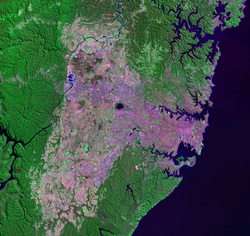| Cumberland Plain Woodland | |
|---|---|
 Grassy plain with scattered eucalypts | |
| Ecology | |
| Realm | Australasia |
| Biome | Tropical and subtropical grasslands, savannas, and shrublands |
| Borders | |
| Geography | |
| Country | Australia |
| Elevation | 10–100 metres (33–328 ft) |
| Coordinates | 33°50′59″S150°54′40″E / 33.84972°S 150.91111°E |
| Geology | Sandstone, shale, laminite and siltstone |
| Climate type | Humid subtropical climate (Cfa) |
| Soil types | Clay, sand (podsol, entisols, lithosols), loam |
The Cumberland Plain Woodland, also known as Cumberland Plain Bushland [1] and Western Sydney woodland, [2] is a grassy woodland community found predominantly in Western Sydney, New South Wales, Australia, that comprises an open tree canopy, a groundcover with grasses and herbs, usually with layers of shrubs and/or small trees. [3]
Contents
- Geography
- Locations
- Ecological communities
- Gallery
- Vegetation
- Wildlife
- Historical description
- See also
- References
- External links
Situated in the Cumberland Plain, the Cumberland Plain Woodland (CPW) is a critically endangered savanna [4] that features dry sclerophyll woodlands, grasslands and/or forests, reminiscent of Mediterranean forests. According to Office of Environment and Heritage, the community falls predominantly within the Coastal Valley Grassy Woodlands region, [5] which are part of the Grassy Woodlands formation found in the eastern corridor of New South Wales. [6]
Currently, less than 6% of the Woodlands remain in small parts distributed across the western suburbs of Sydney, totaling only around 6400 hectares. [7] Cumberland Plain Woodland was listed as an Endangered Ecological Community under the Threatened Species Conservation Act 1995 in June 1997. The greatest threats to the Cumberland Plain Woodland include land clearing for agriculture, urban sprawl and the introduction of harmful weed species. [8]

















